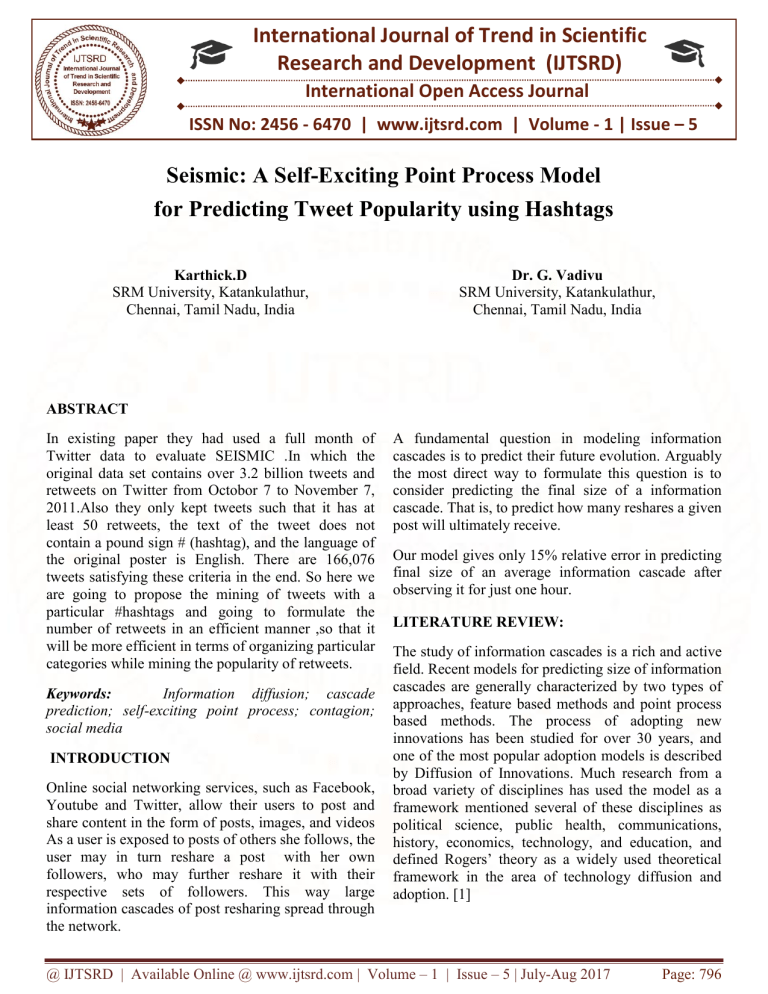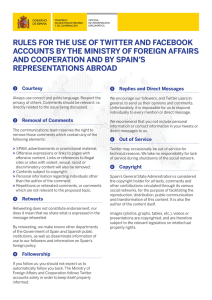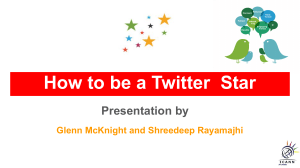
International Journal of Trend in Scientific
Research and Development (IJTSRD)
International Open Access Journal
ISSN No: 2456 - 6470 | www.ijtsrd.com | Volume - 1 | Issue – 5
Seismic: A Self-Exciting Point Process Model
for Predicting Tweet Popularity using Hashtags
Karthick.D
SRM University, Katankulathur,
Chennai, Tamil Nadu, India
Dr. G. Vadivu
SRM University, Katankulathur,
Chennai, Tamil Nadu, India
ABSTRACT
In existing paper they had used a full month of
Twitter data to evaluate SEISMIC .In which the
original data set contains over 3.2 billion tweets and
retweets on Twitter from Octobor 7 to November 7,
2011.Also they only kept tweets such that it has at
least 50 retweets, the text of the tweet does not
contain a pound sign # (hashtag), and the language of
the original poster is English. There are 166,076
tweets satisfying these criteria in the end. So here we
are going to propose the mining of tweets with a
particular #hashtags and going to formulate the
number of retweets in an efficient manner ,so that it
will be more efficient in terms of organizing particular
categories while mining the popularity of retweets.
Keywords:
Information diffusion; cascade
prediction; self-exciting point process; contagion;
social media
INTRODUCTION
Online social networking services, such as Facebook,
Youtube and Twitter, allow their users to post and
share content in the form of posts, images, and videos
As a user is exposed to posts of others she follows, the
user may in turn reshare a post with her own
followers, who may further reshare it with their
respective sets of followers. This way large
information cascades of post resharing spread through
the network.
A fundamental question in modeling information
cascades is to predict their future evolution. Arguably
the most direct way to formulate this question is to
consider predicting the final size of a information
cascade. That is, to predict how many reshares a given
post will ultimately receive.
Our model gives only 15% relative error in predicting
final size of an average information cascade after
observing it for just one hour.
LITERATURE REVIEW:
The study of information cascades is a rich and active
field. Recent models for predicting size of information
cascades are generally characterized by two types of
approaches, feature based methods and point process
based methods. The process of adopting new
innovations has been studied for over 30 years, and
one of the most popular adoption models is described
by Diffusion of Innovations. Much research from a
broad variety of disciplines has used the model as a
framework mentioned several of these disciplines as
political science, public health, communications,
history, economics, technology, and education, and
defined Rogers’ theory as a widely used theoretical
framework in the area of technology diffusion and
adoption. [1]
@ IJTSRD | Available Online @ www.ijtsrd.com | Volume – 1 | Issue – 5 | July-Aug 2017
Page: 796
International Journal of Trend in Scientific Research and Development (IJTSRD) ISSN: 2456-6470
It is widely accepted that some time after the
occurrence of a major earthquake the aftershock
activity dies off and background activity surpases the
aftershock activity. Prior to the next major
earthquake, preseismic quiescence and then
foreshocks are expected to appear in the focal region.
Thus the seismic quiescence and related seismic gap
have been studied by many seismologists for the
purpose of earthquake predictions, from this it is also
useful for the prediction of the the information
cascade of future prediction of final popularity of
retweets.[2]
Social network services have become a viable source
of information for users. In Twitter, information
deemed important by the community propagates
through retweets. Studying the characteristics of such
popular messages is important for a number of tasks,
such as breaking news detection, personalized
message recommendation, viral marketing and others.
We cast the problem of predicting the popularity of
messages into two classification problems: 1) a binary
classification problem that predicts whether or not a
message will be retweeted, and, 2) a multi-class
classification problem that predicts the volume of
retweets a particular message will receive in the near
future. [3]
Modeling and predicting retweeting dynamics in
social me-dia has important implications to an array
of applications. Existing models either fail to model
the
triggering
e
ect of retweeting dynamics, e.g., the model based on
reinforced Poisson process, or are hard to be trained
using only the retweeting dynamics of individual
tweet, e.g., the model based on self-exciting Hawkes
process.Our model is motivated by the observation
that the retweeting process of tweets could be
generally characterized by a di_usion tree with only a
handful of key nodes, each triggering a high number
of retweets.[4]
Retweeting is the key mechanism for information
diffusion in Twitter. It emerged as a simple yet
powerful way of disseminating information in the
Twitter social network. One interesting emergent
behavior in Twitter is the practice of retweeting,
which is the relaying of a tweet that has been written
by another Twitter user. This can be done in one of
two ways. First, one can retweet by preceding it with
RT and addressing the original author with @. For
example, “RT @userA: my experience with the new
#iPad is great!” Second, Twitter also enables users to
retweet easily with one-click. [5]
EXISTING SYSTEM:
In present they had used a full month of Twitter data
to evaluate SEISMIC .In which the original data set
contains over 3.2 billion tweets and retweets on
Twitter from Octobor 7 to November 7, 2011.Also
they only kept tweets such that it has at least 50
retweets, the text of the tweet does not contain a
pound sign # (hashtag), and the language of the
original poster is English. There are 166,076 tweets
satisfying these criteria in the end
PROPOSED SYSTEM:
So here we are going to propose the mining of tweets
with a particular #hashtags and going to formulate
the number of retweets in an efficient manner, so
that it will be more efficient in terms of organizing
particular categories while mining the popularity of
retweets.
METHODOLOGY:
In this project we are going to formulate the total
number of retweets i.e, the popularity of the tweets
with the help of SEISMIC (self exciting point
process) algorithm .Initially with the help of the
twitter application we made an authentication, with
the help of Rstudio. In which it requires the following
packages such as Seismic, twitter, devtools. After
Installing necessary packages, then we have to
retrieve the data from the twitter, generally we can
search
tweets
in
twitter
using
searchtwitteR(“example”). Then by defining the
retweet pattern we were going to fetch the tweets that
has been retweeted, over a period of time with the
certain attributed such as, tweeted, time, date, is
retweeted. The major methodology is that we were
retrieving the data with hashtags, by mentioning the
number of tweets that has to be retrieved. So After
retrieving the tweets we are going to store it in a data
frame to write it to a csv file. After the completion
now we could be able to analyze the content
graphically in exploratory with the total number of
estimated parameters. The sequential process of the
methodology is given with the flow diagram below.
@ IJTSRD | Available Online @ www.ijtsrd.com | Volume – 1 | Issue – 5 | July-Aug 2017
Page: 797
International Journal of Trend in Scientific Research and Development (IJTSRD) ISSN: 2456-6470
FIG 1: Methodology
ALGORITHM USED:
SEISMIC:
Purpose: For a given post at time t, predict its final reshare count
Input: Post resharing information: ti and ni for i = 0; : : : ;Rt.
SEISMIC models the information cascade as a self-exciting point process. In a self-exciting point process, each
reshare not only increases the cumulative count by one, it also exposes new followers who may further reshare
the post. This property is ideal to model the "rich get richer" phenomenon in information spreading.
@ IJTSRD | Available Online @ www.ijtsrd.com | Volume – 1 | Issue – 5 | July-Aug 2017
Page: 798
International Journal of Trend in Scientific Research and Development (IJTSRD) ISSN: 2456-6470
SEISMIC implements a fast kernel weighted method to estimate the temporally evolving infectiousness, which
fully characterizes an information cascade. Roughly speaking, it measures how likely the post will be reshared
at that time. Then, if the infectiousness is smaller than a threshold, SEISMIC can accurately predicts the final
popularity of the post.
NETWORK DIAGRAM:
Fig 2: Network Diagram
BETWEENESS CENTRALITY:
In graph theory, betweeness centrality is a measure of centrality in a graph based on shortest paths.
CODE:
DISTANCE-WEIGHTED BETWEENNESS:
1
2
3
4
5
6
7
8
9
DW
rashishetty764
Aditya74115170
Aditya74115170
Aditya74115170
sujithindia
mateguy26
NarendraModi1FC
SupportModi_
SupportModi_
Betweenness
5.379
12.303
41.807
5.695
3.020
12.400
12.512
0
0
@ IJTSRD | Available Online @ www.ijtsrd.com | Volume – 1 | Issue – 5 | July-Aug 2017
Page: 799
International Journal of Trend in Scientific Research and Development (IJTSRD) ISSN: 2456-6470
10
11
12
universalthamil
Godse7Shankar
SupportModi_
0
0
0
EXPLANATION:
This is a simple stochastic algorithm to generate a graph. It is a discrete time step model and in each time step a
single vertex is added. We start with a single vertex and no edges in the first time step. Then we add one vertex
in each time step and the new vertex initiates some edges to old vertices. The probability that an old vertex is
chosen is given by
P[i] ∼ k α i + a
sample_pa generates a directed graph by default, set directed to FALSE to generate an undirected graph. Note
that even if an undirected graph is generated ki denotes the number of adjacent edges not initiated by the vertex
itself and not the total (in- + out-) degree of the vertex, unless the out.pref argument is set to TRUE.
OUTPUT:
FIG 3: RSTUDIO
The above screen shot is a retrieval of retweets with the hashtag narendramodi
@ IJTSRD | Available Online @ www.ijtsrd.com | Volume – 1 | Issue – 5 | July-Aug 2017
Page: 800
International Journal of Trend in Scientific Research and Development (IJTSRD) ISSN: 2456-6470
.
FIG 4: EXPLORATORY ANALYSIS
The above screen shot is a summary of retweets
FIG 5: EXPLORATORY ANALYSIS
From here we infer the graphical data of the retweets
CONCLUSION
Our approach provides a theoretical framework for
explaining
temporal
patterns
ofinformation
cascades.SEISMIC is both scalable and accurate. The
model requires no feature engineering and scales
linearly with the number of observed reshares of a
given post. This provides a way to predict information
@ IJTSRD | Available Online @ www.ijtsrd.com | Volume – 1 | Issue – 5 | July-Aug 2017
Page: 801
International Journal of Trend in Scientific Research and Development (IJTSRD) ISSN: 2456-6470
spread for millions of posts in an online real-time
setting. SEISMIC brings extra flexibility to estimation
and rediction tasks as it requires minimal knowledge
about the information cascade as well as the
underlying network structure. Thus the future
enhancement could be come up with even more less
relative error.
ACKNOWLEDGEMENTS:
This research has been supported by ucinet,
exploratory, Rstudio.
RESULT:
The output is basically where the total number of
retweets is analyzed, and then the Information cascade
has been predicted. Below are some screenshots after
implementing cascade.
FIG 6: CASCADE CURVE
REFERENCES:
1) S. Gao, J. Ma, and Z. Chen. Modeling and
predicting retweeting dynamics on microblogging
platforms.
In WSDM’ 15, 2015.
2) A. G. Hawkes. Spectra of some self-exciting and
mutually exciting point processes. Biometrika,
58(1), 1971.
3) L. Hong, O. Dan, and B. D. Davison. Predicting
popular messages in twitter. In WWW ’11, 2011.
4) E. M. Rogers. Diffusion of innovations. Simon
and Schuster, 2010.
5) B. Suh, L. Hong, P. Pirolli, and E. H. Chi. Want to
be retweeted? large scale analytics on factors
pacting
retweet
in twitter network. In
SOCIALCOM ’10, 2010.
6) https://twitter.com/mottbollomy/status/
127001313513967616.
7) D. Agarwal, B.-C. Chen, and P. Elango. Spatiotemporal models for estimating click-through rate.
In WWW ’09, 2009.
8) E. Bakshy, J. M. Hofman, W. A. Mason, and D. J.
Watts.
Everyone’s an influencer: quantifying influence
on twitter. In WSDM ’11, 2011.
9) R. Bandari, S. Asur, and B. A. Huberman. The
pulse of news in social media: Forecasting
popularity. In ICWSM ’12,
pages 26–33, 2012.
10) A.-L. Barabasi. The origin of bursts and heavy
tails in human dynamics. Nature, 435:207, 2005.
11) J. Cheng, L. Adamic, P. A. Dow, J. M. Kleinberg,
and J. Leskovec. Can cascades be predicted? In
WWW ’14, 2014.
12) R. Crane and D. Sornette. Robust dynamic classes
revealed by measuring the response function of a
social system. PNAS, 105(41), 2008.
13) H. Daneshmand, M. Gomez-Rodriguez, L. Song,
and B. Schölkopf. Estimating diffusion network
structures:
Recovery
conditions,
sample
complexity & soft-thresholding algorithm. In
ICML ’14, 2014.
14) P. A. Dow, L. A. Adamic, and A. Friggeri. The
anatomy of large facebook cascades. In ICWSM
’13, 2013.
15) N. Du, L. Song, M. Yuan, and A. J. Smola.
Learning networks of heterogeneous influence. In
NIPS ’12, 2012.
16) R. Durrett. Probability: theory and examples.
Cambridge university press, 2010.
17) M. Gomez-Rodriguez, J. Leskovec, D. Balduzzi,
and B. Schölkopf. Uncovering the structure and
temporal dynamics of information propagation.
Network Science, 2:26–65, 4 2014.
18) R Vidhya, G Vadivu, Research Document Search
using Elastic Search, Indian Journal of Science
and Technology 9 (37), 2016.
19) T. Y. J. Naga Malleswari , G. Vadivu, “Map
reduce: A Technical Review”, Indian Journal of
Science and Technology, Vol 9(1), January 2016.
20) K.Sornalakshmi, G.Vadivu,
“A Survey on
Realtime Analytics Framework for Smart Grid
Energy Management”, International Journal of
Innovative Research in Science, Engineering and
Technology, March 2015.
FUTURE ENHANCEMENT:
Enhancing the retweet count even more with less
relative error.
Improvizing the efficiency of mining.
@ IJTSRD | Available Online @ www.ijtsrd.com | Volume – 1 | Issue – 5 | July-Aug 2017
Page: 802







